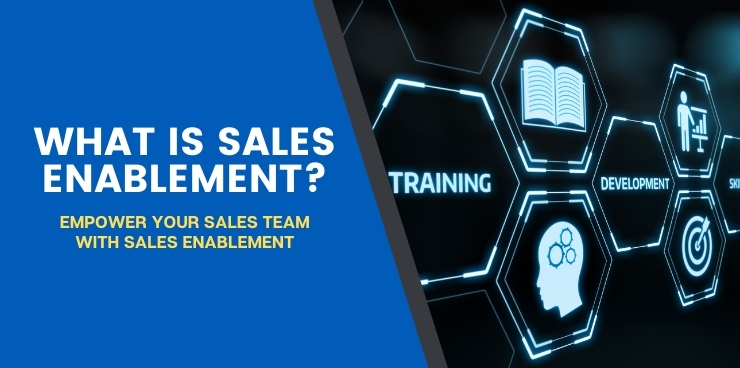With broader and better solutions available today, modern B2B customers are more informed and discerning than ever. To thrive in sales-focused environments, it is no longer enough to emphasize skills training. Support makes the difference for winning sales teams.
When two competing teams are equally skilled and knowledgeable, the one with more ammunition will come out on top. To close prospects, sales teams need the right resources to create strong connections and compelling presentations. This focus on finding, developing and implementing those resources is the essence of sales enablement.
With an informed emphasis on sales enablement, teams benefit from better tools and content in their sales efforts. This article will define sales enablement and offer helpful guidelines and resources to help you build an effective strategy.
What is Sales Enablement?
Sales enablement is an ongoing process of supplying salespeople with the necessary resources to maximize their close rate. Resources include training, tools and technology, content and guidance to improve their customer interactions. These encompass support for salespeople to improve their proficiency as well as material they can offer to the customer.
With sales enablement, the organization empowers its entire sales team to offer the best customer service. It continually evolves, as leaders measure effectiveness and adjust their approach to better meet their sales reps’ needs. When properly executed, sales enablement improves team-wide customer connection, customization and closing, ideally generating predictable results.
What is a Sales Enablement Strategy?
A sales enablement strategy is a company’s unique approach to equipping sales reps with the resources to sell effectively. The strategy is centered around the company’s particular goals, sales team needs and target consumers. Sales enablement strategies can be used to accomplish a number of sales objectives, including the following:
- Shortening sales cycles.
- Enhancing the customer experience.
- Increasing close rates.
- Building larger deals.
- Expanding into new markets.
- Improving customer retention.
Marketing and sales departments are often the key developers and executors of sales enablement strategies. The sales side measures effectiveness and monitors salesperson needs. Marketing uses that information to create and gather the resources to fill the opportunity gaps and increase sales effectiveness.
What are the Various Aspects of Sales Enablement?
Sales enablement is a customized process, so no two strategies will look exactly the same. It can seem confusing to start, but general frameworks and focus areas have been established over time for guidance. Let’s look at the four essential aspects of sales enablement:
Reporting and Analysis
With technology integrations touching every point of the modern sales cycle, the amount of available data is virtually limitless. This double-edged sword offers in-depth analysis but also an overwhelming and unmanageable amount of information. By understanding your business priorities, you and your team can devise ways to add utility to the numbers. Here are some of the most effective methods for putting your data to work:
Standardize Reporting
A common sales enablement tool is standardized sales reporting. Sales and business leaders collaborate to identify which metrics align with organizational goals. They can then work with technical professionals to generate digestible reports that cover consistent standards across the entire team. Common reports used sales managers may implement include:
- Close rates.
- Leads generated by salespeople.
- Lead conversion rates.
- Presentations executed.
- Average deal size.
Review Sales Process
Monitoring movement through the sales cycle with company reports can indicate opportunities in the process. These reports measure success at every step of the sales cycle, identifying bottlenecks and losses. For instance, a high number of presentations but a low number of closed deals could indicate issues with objections.
Auditing these reports allows trainers to discover where performance is lacking. By focusing the training on overcoming these deficiencies, they can move closer to optimizing the full sales cycle.
Qualify Leads
With limited time to spare, salespeople cannot afford to get bogged down with poor fits for their solutions. Chasing empty leads can waste time, hurt metrics, bury motivation and negatively affect future interactions. Qualifying leads effectively is one of the most critical skills to maximize your sales reps’ conversion rates.
Sales enablement experts use lead scoring to signify a lead’s interest and potential to buy. Scores are determined by different positive and negative weights that often match buyer persona details. These can include demographic or geographic data, among others. For example, a business marketing to customers in a limited area will assign positive weights to local leads. Leads from different states or countries would be negatively weighted.
By creating a consistent scoring system, you can better assess success by customer type and continually improve qualification practices. Scoring can be integrated along with marketing automation like CRM software, instantly ranking and prioritizing leads.
Sales Content Optimization
Quality sales content is an extension of your brand, one that can greatly benefit the customer experience. Digital and print content is more than just a job for the marketing department. As the one driving the customer relationship, salespeople can also generate impactful, individualized content.
Time is precious for salespeople, and it’s best spent on working with leads. However, there are several ways for your sales reps to create purposeful content without shortchanging their customers.
Organize Sales Content
Getting the most out of pre-existing content and collateral is an efficient starting point to content optimization. Through the organization, you can create a more usable system for reps to quickly share relevant material with customers. The following are some different content types worth organizing:
- Case studies.
- Brochures and product sheets.
- Whitepapers.
- Demo decks.
- Templates.
Create virtual libraries in internal training systems, Google Docs or CRMs. It is crucial to schedule regular updates, as dated data and irrelevant material need to be cleaned out.
Create Case Studies
Customer success stories make your solutions real, and prospects use case studies as serious indicators of quality. Developing customer case studies should be a priority with each product launch. Within a few months of introduction to the market, you should investigate potential case study candidates.
Salespeople are excellent managers of case study creation. They may not write them personally, but their insights and hands-on experience add depth and meaning. They are acutely aware of the customer’s pre-solution challenges. Ideally, they have also done the requisite post-sale follow-up to speak to its efficacy for the customer. You can leverage salespeople to identify great customer stories as they work their CRM.
Create Email Templates
From lead generation to post-sale follow-up, email is the go-to medium for effective customer communication. Email copy can be tedious, and if salespeople consistently spend time on one task, it is writing personalized emails.
Email templates are a valuable tool that are easy to develop and put in the salesperson’s rotation. These outlines should be rigid enough to increase speed but flexible enough to customize to a particular reader. Having templates organized in shared folders can make them readily accessible for team members drawing up emails.
 Technology and Automation
Technology and Automation
When a sales team has reached the peak of skills and knowledge, sales automation pushes them to new heights. B2B companies offering the highest-quality tools to run sales cycle minutiae allow reps to sell faster and more consistently. We will explore three key initiatives that can immediately save your reps valuable time.
Create Email Sequences
The next stage of automation after email templates is email sequences. For each prospect, you can schedule follow-up ahead of time and the system runs itself. And even though emails are sent automatically, you still have personalization features to cater to the individual.
Automate Prospecting
Prospecting tools give users real-time access to lead engagement. Salespeople can filter and sort prospects to add priority and adjust their email schedules. Adding in a call scheduling option to prospecting emails makes customers come to you. This takes out a sizable chunk of the prospecting process.
Use Sales Enablement Software
Sales enablement software is the hub for all of the shared resources and content. Teams can use software to easily collaborate in building and editing materials. Sales reps have an intuitive, organized resource center to access the best material when needed.
Top 8 Sales Enablement Tools
Sales enablement tools are essential to lifting your team above the competition. With the right tools in place, salespeople can efficiently direct their efforts toward faster, more consistent closes. Here are the top eight sales enablement tools worth considering:
Whatfix
Whatfix is a digital adoption platform (DAP) that integrates with company sales software to teach and guide users. Businesses can use it to automate training on new software and speed adoption rates. From onboarding to ongoing training, use the power of Whatfix to quickly get sales reps up to speed on the latest tools.
Sales reps are able to use real-time walkthroughs to learn the quickest methods for accomplishing tasks. Managers are also able to customize the training with quick guides, videos and slideshows.
Highspot
Highspot’s sales enablement platform equips salespeople with purposeful content that can enrich customer conversations. Their AI-powered software can intelligently filter and provide content, templates and resources based on lead characteristics. It integrates with sales tools and databases to make content easily accessible.
Along with smart content recommendations, Highspot offers advanced analytics for sales and marketing teams. Users can track the performance of content along the sales cycle for ongoing optimization.
Showpad
Similar to Highspot, Showpad supplies relevant content to sales reps for better responsiveness and impact. With a user-friendly interface, salespeople can efficiently find the resources to drive engagement. Their platform promises to improve sales and marketing productivity while also facilitating faster onboarding.
Showpad integrates with numerous customer contact technology, including email services, CRM and social media platforms. The intuitive format makes it easy for salespeople to customize their approach and analyze the effectiveness of their content use.
Unboxed Advisor
Unboxed Advisor was designed to reduce training time by giving sales reps support and on-demand guidance. The Dynamic Recommendation Engine provides sales reps with frameworks to guide interactions and develop consistent experiences. It also assesses customer needs and inputs to provide more tailored content recommendations.
The software is built to boost the salesperson’s value to the customer. Salespeople can follow effective guides and recommendations to save time and streamline the sales process. The customer experience is richer, and the system’s support improves retention and upselling opportunities.
Hoopla
Sales enablement apps take a fun turn with Hoopla’s motivational software. Hoopla captures the sales team’s competitive nature, turning metrics into performance boosters.
An enthusiastic, engaged sales team will win more deals. Hoopla uses game mechanics to create head-to-head challenges between sales reps and leaderboards showcasing top performers. Sharing broadcast video company-wide, allows coworkers to own a stake in performance and share in successes. It benefits the company culture while also giving feedback on opportunities and potential.
 Salesloft
Salesloft
Salesloft integrates with Salesforce and other CRMs to make it easy to analyze sales actions. It automates many common tasks, such as sending follow-up emails and posting to social media. The consistency in follow-up ensures leads are properly nurtured and moved through the sales funnel.
The technology also offers analysis, with the Sync Log lending insights stemming from sales activities and their results. Managers can better understand conversations, allowing them to replicate positive behaviors and give the entire sales team a boost.
DocSend
Gauging the power of your presentations can demystify who is interested in your solutions and why. DocSend is geared towards helping salespeople monitor interactions with their presentations to better prioritize prospects. Through detailed analytics showing who looks at what features in sales decks, DocSend lets reps better position customer conversations.
With insights from DocSend, sales reps can fine-tune their sales decks for stronger read rates. They can also continually update documents to ensure customers always have the latest information available.
Guru
The knowledge management solution from Guru is a powerful organizational tool for teams needing on-demand content. With email and Slack integration, salespeople can locate relevant material without having to change windows or take time searching. Using their premium Wiki platform, Guru provides a system of faster onboarding, efficient internal communication and improved responsiveness.
Sales enablement will continue to grow as a critical factor of sales team effectiveness as technology improves. Salesperson training takes priority but an honest sales enablement effort will support and add efficiency to that training. With sales enablement, your sales team can focus on selling, and the results will show in your bottom line.
If you need help implementing a sales enablement strategy to boost your revenue, Selling Revolution is here to help. We work closely with clients to identify goals and opportunities to create winning strategies. From onboarding to influencing the sales cycle, our consultants drive proficiency and efficiency where you need it. To learn more about how we can help you realize your organizational goals, book an introductory call with us today.



 Technology and Automation
Technology and Automation Salesloft
Salesloft